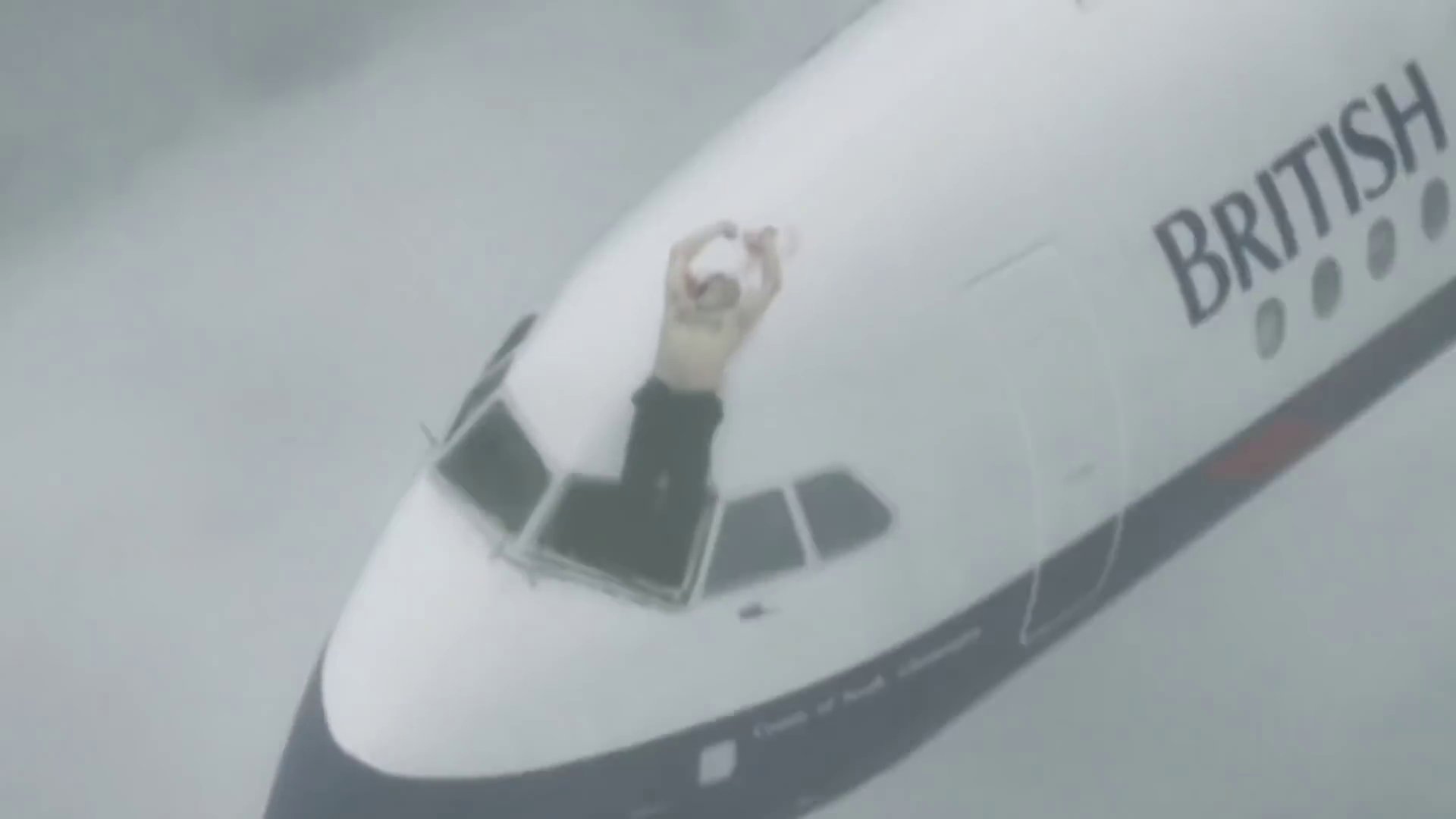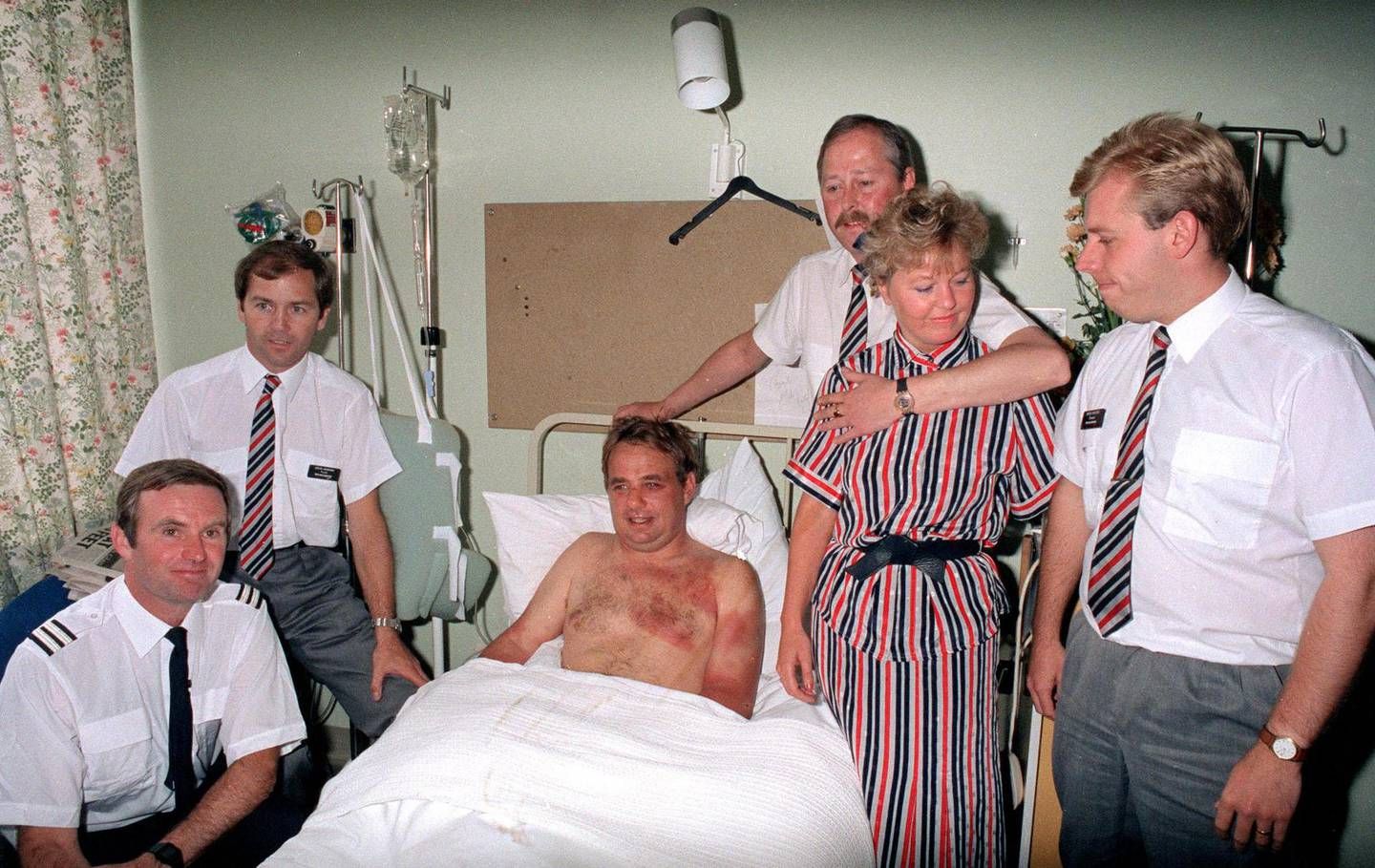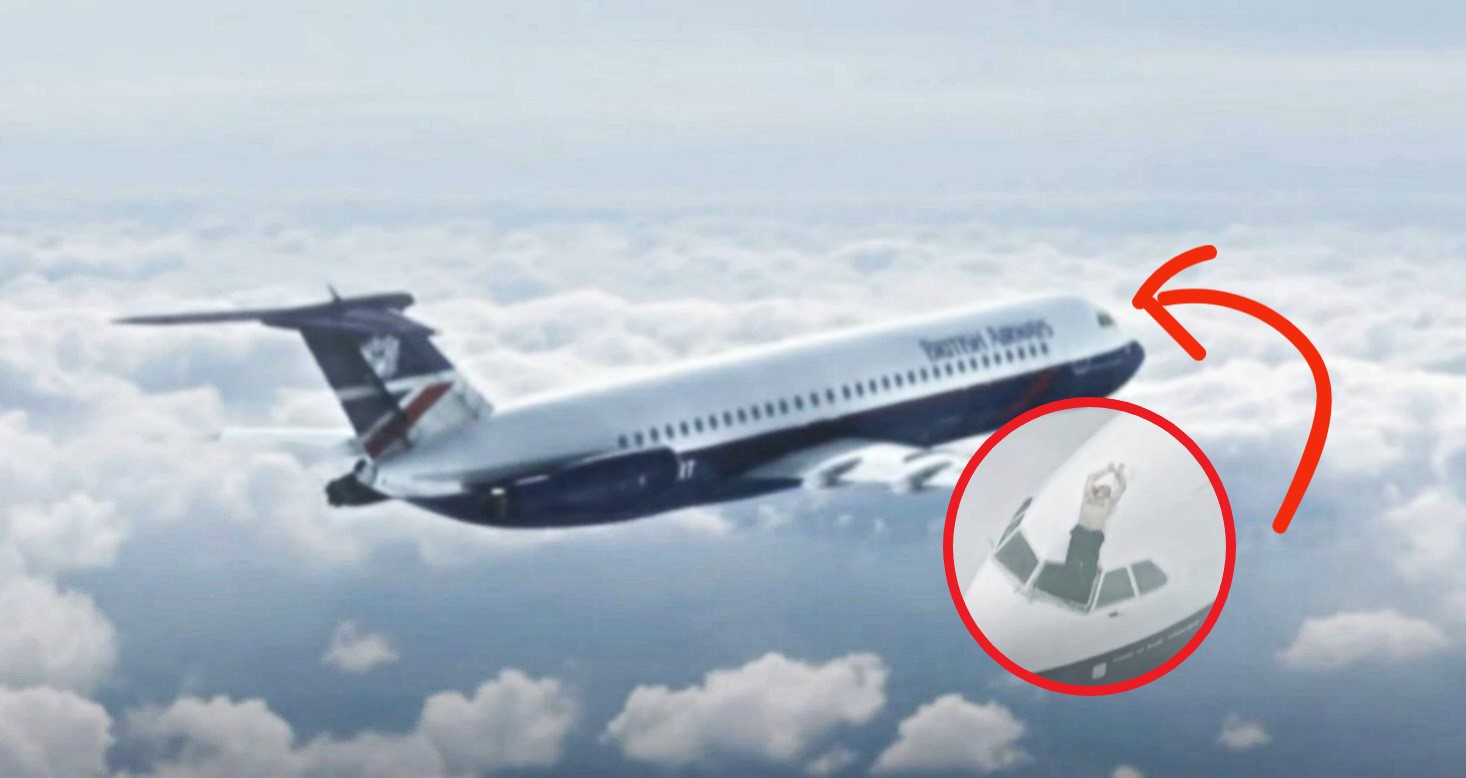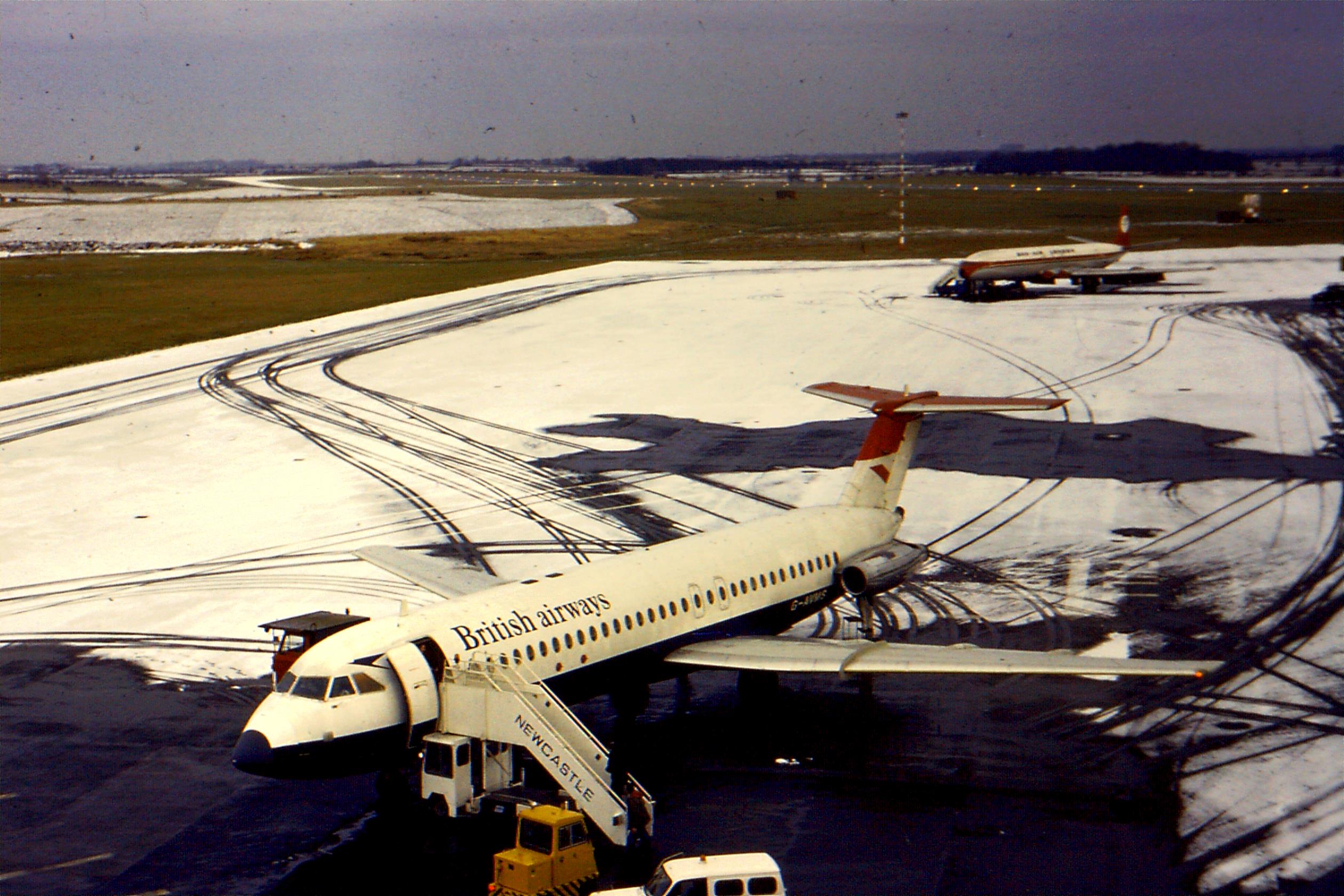
On June 10, 1990, British Airways Flight 5390 took off from Birmingham Airport bound for Malaga, Spain—a routine three-hour journey that quickly spiraled into an unimaginable nightmare.
The skies were clear, the aircraft in perfect condition, and the passengers prepared for a relaxed and uneventful flight.
In the cockpit, Captain Tim Lancaster, a seasoned pilot with over 11,000 hours of flying experience, was accompanied by co-pilot Alastair Atchison, who himself had logged nearly 8,000 hours.
The pilots had never flown together before, yet they quickly established a comfortable rapport, confidently navigating the initial moments of the flight.
As Flight 5390 ascended and settled into cruising altitude, the passengers relaxed, completely unaware that disaster was just moments away.
After a routine check and activating the autopilot, Captain Lancaster loosened his seatbelt, making himself comfortable for the smooth ride ahead.
The steward, Nigel Ogden, stepped briefly into the cockpit to take the pilots' breakfast orders, promising to return shortly with tea. At that precise moment, the calm was abruptly shattered.
Without any warning, two cockpit windows exploded outward violently, creating an instant, catastrophic decompression event.

The enormous force generated by the sudden change in air pressure tore the cockpit door from its hinges, propelling Captain Lancaster out of his seat and through the shattered window.
Miraculously, his legs caught awkwardly, jamming against the cockpit controls and preventing his immediate ejection from the aircraft entirely.
His upper body was now pressed against the fuselage outside the aircraft, battered by violent winds and freezing temperatures as the plane continued hurtling through the sky.
Inside the cabin, steward Nigel Ogden had witnessed the explosive decompression and immediately sprang into action. Ignoring his own fear, he lunged forward and desperately grabbed hold of Lancaster's legs to prevent the captain from slipping out completely.
In the chaos, the cockpit became an unbearably loud wind tunnel filled with blinding fog and debris. Co-pilot Atchison struggled to regain control of the aircraft, but Lancaster's trapped legs jammed the controls, sending the plane diving uncontrollably through crowded airspace.
With no visibility, freezing temperatures, and intense noise, the co-pilot faced an almost impossible task.
Within moments, Ogden was joined by two other crew members who formed a human chain, bravely anchoring themselves inside the cockpit to secure their captain.

With great physical effort, they managed to move Lancaster's legs from the controls, enabling Atchison to regain control of the plunging aircraft.
Even then, the captain remained perilously suspended, vulnerable to being sucked into the plane's engines, potentially causing a catastrophic failure and dooming all on board.
Once the plane was stabilized at a lower altitude, Atchison managed to establish radio communication with air traffic control, urgently requesting an emergency landing at the nearest airport.
He was swiftly directed toward Southampton Airport, an unfamiliar destination with a runway shorter than ideal and no opportunity to dump excess fuel.
Without maps, charts, or reference materials—which had been sucked out during the explosive decompression—Atchison was effectively flying blind, guided only by the calm instructions of controllers on the ground.
Approaching Southampton, Atchison faced a landing scenario most pilots would find unimaginable. Battling freezing winds, his co-pilot trapped outside the aircraft window, and the heavy plane full of fuel, he had to execute a flawless landing under immense pressure.

Against all odds, Atchison landed the damaged aircraft with incredible precision, bringing it safely onto the runway. Emergency crews rushed to the scene, anticipating the worst.
As the passengers were safely evacuated, rescue teams carefully retrieved Captain Lancaster from outside the plane, expecting to find him deceased after the prolonged exposure to freezing conditions and violent turbulence. Amazingly, Lancaster had survived.
Despite broken bones, severe frostbite, and extensive cuts, he would recover fully, astonishing doctors and rescue workers alike. Within days, he was conscious, responsive, and speaking to the press from his hospital bed, recounting the harrowing ordeal.
Following the near-tragedy, investigators quickly determined the cause of the cockpit window failure. Incredibly, tiny errors had created the life-threatening scenario: maintenance workers had inadvertently installed incorrect-sized bolts during a routine windshield replacement.
These bolts, a mere fraction of a millimeter too small in width and just a few millimeters too short, had created a structural weakness. Under the extreme pressure at cruising altitude, this weakness led to the explosive decompression.
Investigations revealed multiple procedural lapses, including failure to consult manuals, improper visual matching of parts, and neglecting to double-check the work.

The incident prompted significant changes in maintenance procedures across the aviation industry. British Airways and other airlines immediately strengthened their quality control processes, ensuring precise compliance with maintenance manuals and instituting mandatory checks of windshield bolt installations across all fleets.
Captain Lancaster eventually returned to flying commercial aircraft, his resilience and survival becoming an inspiration to many.
Co-pilot Atchison received accolades and recognition for his extraordinary composure and skill under pressure. The cabin crew, especially steward Nigel Ogden, were rightly praised as heroes, their quick thinking and courage directly contributing to Lancaster's survival and the safety of everyone aboard.
British Airways Flight 5390 became a landmark case study in aviation safety, a remarkable example of both how minor oversights could trigger catastrophic events, and how bravery, teamwork, and exceptional piloting could overcome seemingly impossible circumstances.

The incident was also instrumental in emphasizing to airline operators and engineers worldwide the importance of meticulous adherence to established safety protocols, underscoring how even minuscule deviations could result in near-fatal incidents.
Ultimately, the story of Flight 5390 is more than just an aviation miracle. It is a testament to human courage and ingenuity, highlighting the extraordinary efforts of an ordinary crew facing extraordinary circumstances.
It serves as a powerful reminder of aviation's inherent risks and the constant vigilance necessary to maintain passenger safety.
Decades later, the dramatic events of British Airways Flight 5390 remain legendary, not only for the remarkable survival of all on board but also as a cautionary tale that transformed airline safety procedures.
It stands as a vivid example of how swift thinking, heroic actions, and calm under pressure can mean the difference between disaster and survival.
For the crew and passengers aboard Flight 5390, split-second decisions, both in causing and preventing catastrophe, forever defined their lives, reminding us all how fragile yet resilient the human spirit can be at 17,000 feet above the earth.
-1751182359-q80.webp)
-1751177822-q80.webp)
-1750393785-q80.webp)
